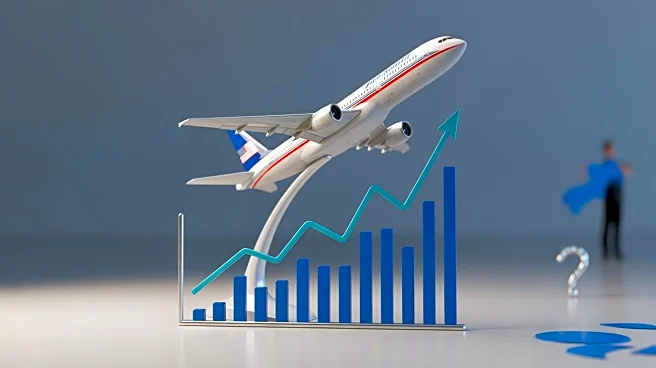What's Happening?
U.S. airlines have experienced a stabilization in the domestic market following a mid-year decision to reduce capacity growth, which was unexpectedly bolstered by a rebound in corporate travel. According
to Airlines for America (A4A) Chief Economist John Heimlich, airlines scaled back their growth plans in July, leading to stabilized yields and load factors in the third quarter. The domestic capacity grew by 2.5% year over year in the second quarter but was reduced to 0.4% in the third quarter. Airfares, adjusted for inflation, showed a decline earlier in the year but stabilized after the capacity reduction. The resurgence in corporate travel has provided a cushion against the negative impacts of a prolonged U.S. government shutdown, which has affected government-related travel. The shutdown, lasting over a month, poses a risk to airlines' finances due to the uncertainty over system reliability and the potential for reduced consumer spending.
Why It's Important?
The rebound in corporate travel is significant as it helps offset the challenges posed by the ongoing government shutdown, which affects federal and government-associated travel. This shift in travel dynamics highlights the importance of corporate passengers who contribute to airline revenues through premium services and international travel. The stabilization of airfares and load factors indicates a potential recovery in the airline industry, which has been struggling with low profit margins and operational inefficiencies. The situation underscores the vulnerability of airlines to external factors such as government policies and economic conditions, emphasizing the need for strategic adjustments in capacity and service offerings.
What's Next?
If the government shutdown continues, airlines may face further financial strain due to reduced government-related travel and consumer spending. The industry may need to explore alternative revenue streams and operational efficiencies to mitigate these impacts. Additionally, airlines might capitalize on tactical opportunities arising from Spirit Airlines' capacity reduction, as competitors like JetBlue Airways expand their presence in key markets such as Fort Lauderdale-Hollywood International Airport. The ongoing challenges with air traffic control staffing shortages and maintenance costs will require attention to ensure sustainable growth and profitability.
Beyond the Headlines
The current dynamics in the airline industry reflect broader economic and policy challenges, including the impact of inflation and a weakening job market on consumer behavior. The reliance on corporate travel highlights the disparity between different passenger segments and the need for airlines to adapt to changing demand patterns. The situation also raises questions about the resilience of the airline industry in the face of political and economic uncertainties, prompting discussions on long-term strategies for stability and growth.











